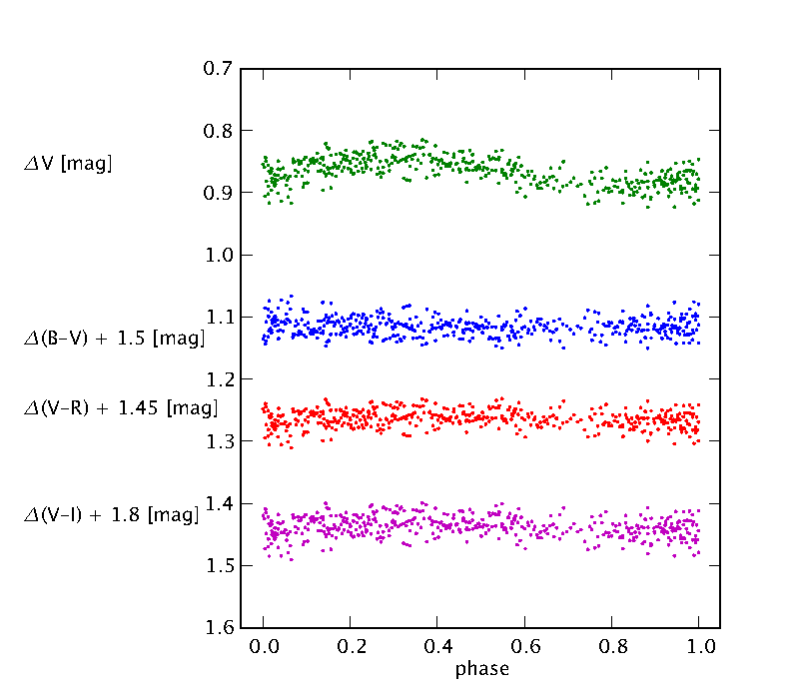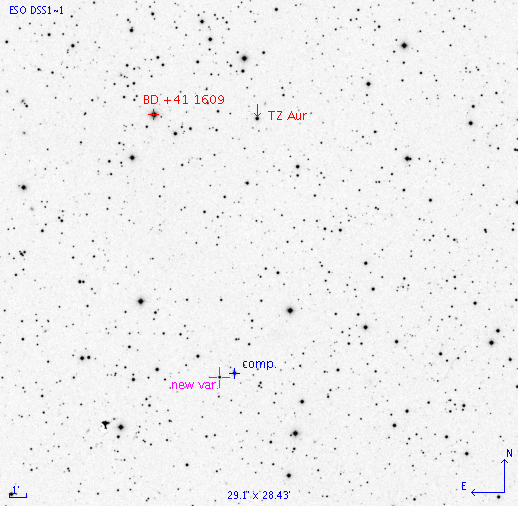"Peremennye Zvezdy",
Prilozhenie,
vol. 6, N 19 (2006)
Prilozhenie,
vol. 6, N 19 (2006)
A New Ellipsoidal Variable in Auriga
I. Dékány, J. Jurcsik, M. Váradi
Konkoly Observatory of the Hungarian Academy of Sciences, Budapest, Hungary
Received: 10.08.2006; accepted: 7.09.2006
(E-mail for contact: dyin@elte.hu)
| ||||||||||||||||||||||
Remarks: |
| The variability of the star USNO-B1.0 1305-0178165 has been detected
during our targeted observations of TZ Aurigæ (Jurcsik et al.
2006). Four-colour CCD-photometry was performed between JD 2453329
– 2453358 with the 60 cm telescope of the Konkoly Observatory
(Budapest), using a Wright CCD detector (750×1100, FOV=17'×24'). Data
processing and relative aperture photometry of the star was done using
standard IRAF packages. We have used the nearby USNO-B1.0 1305-0178144
as a comparison star. Magnitudes have been transformed into the standard
BV(RI)C system. Our photometric data are available in the
attachment to this article.
Fourier-decomposition of the light curves shows frequency peaks at 1.55 c/d and its ±1.0 day aliases. Although there is some ambiguity which of these frequency components is the real frequency of the light variation, 1.55 c/d gives the best fit. V lightcurve and B-V, V-RC, V-IC colour index curves are shown, folded with the period of P=0.645 days. There is very small if any variation in the colour indices, which suggests that the light variation of the star is not caused by pulsation. There is no sign of secondary minima, which implies that the object is most probably a binary showing ellipsoidal light variation. The ratio of the amplitudes of the B and V light curves is 1, which underpins that the variability type of the source is ELL. Average B-V colour index of the star is 0.565, estimated from the B-V magnitudes of our observations of BD+41 1609 which was the only star in our field of view that had published standard UBV magnitudes (Stepien 1972). This corresponds to the effective temperature of approximately 6100K (Castelli et al., 1997). The 2MASS colour indices of the object are J-H=0.248 and J-K=0.273 (Skrutskie et al., 2006) which give an effective temperature of 6300K, in the case of a solar-like star, according to the theoretical isochrones for 2MASS filters of the Padova database (Bonatto et al., 2004). The infrared and optical colours give consistent tempertures, although our B-V colour index gives a slightly lower temperature, which might be due to some hundredths of magnitudes of interstellar reddening in the direction of the variable. These temperature values presume that the spectral type of the object is most probably late F. Acknowledgements: The financial support of OTKA grant T-043504 is acknowledged. This research has made use of Aladin and the Simbad database, operated at CDS, Strasbourg, France. IRAF is distributed by the National Optical Astronomy Observatories, which are operated by the Association of Universities for Research in Astronomy, Inc., under cooperative agreement with the National Science Foundation. This publication makes use of data products from the Two Micron All Sky Survey, which is a joint project of the University of Massachusetts and the Infrared Processing and Analysis Center/California Institute of Technology, funded by the National Aeronautics and Space Administration and the National Science Foundation. |
| References: |
| Bonatto, C., Bica, E., Girardi, L., 2004, A&A 415, 571 Castelli, F., Gratton, R. G., Kurucz, R. L., 1997, A&A 318, 841 Jurcsik, J. et al., 2006, IBVS 5709 Skrutskie, M. F. et al., 2006, AJ, 131, 1163 Stepien, K., 1972, AcA, 22, 175 |
Light Curve
USNO-B1.0 1305-0178165 relative V light curve and relative B-V, V-RC and V-IC colour index curves, from top to bottom, respectively, folded with the 0.645d period of the variation. Finding Chart 
Finding chart showing the 21.9'×28.43' vicinity of the new variable. Data Source |